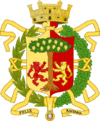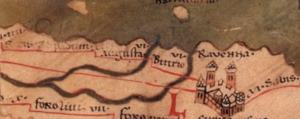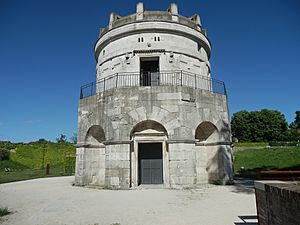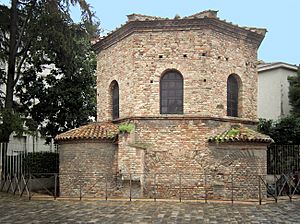Ravenna facts for kids
|
||||||||||||||||||||||||||||||||||||||||||||||||||||||
Ravenna is a historic city in the Emilia-Romagna region of Northern Italy. It's famous for its amazing ancient buildings and beautiful mosaics. The city was once a very important capital.
Ravenna was the capital of the Western Roman Empire in the 5th century. After that, it became the capital of the Ostrogothic Kingdom. Later, it was the main city for the Byzantine Empire in Italy.
Even though it's now inland, Ravenna is connected to the Adriatic Sea by a canal. Eight of its early Christian buildings are part of a UNESCO World Heritage Site. Because of its many stunning mosaics, Ravenna is often called the "capital of mosaics."
Contents
Exploring Ravenna's Past: A Journey Through Time
The name Ravenna has a mysterious origin. Some people think it might be linked to "Rasenna," a name the ancient Etruscans used for themselves.
Ancient Beginnings: From Umbri to Roman Power
Ravenna's story goes back a long way. The first people known to live here were the Umbri, around 500 BC. They built their homes on stilts over a marshy lagoon, much like Venice would be centuries later.
The Romans took control of Ravenna in 89 BC. Later, Emperor Augustus built a big military harbor called Classis nearby. This harbor was very important for the Roman Imperial Fleet.
In 402 AD, Emperor Honorius moved the capital of the Western Roman Empire to Ravenna. This made Ravenna the most important city in the Western Roman Empire for most of the 5th century. It was chosen because the surrounding swamps made it easy to defend.
The city grew and became very rich under Roman rule. Emperor Trajan even built a long aqueduct to bring water to the city. Ravenna was home to about 50,000 people at its peak.
Ostrogothic Kingdom: The Reign of Theodoric the Great
After the Western Roman Empire fell in 476 AD, a general named Odoacer ruled Italy. But in 489 AD, the Ostrogoth King Theodoric the Great came and took over. Theodoric made Ravenna the capital of his new Ostrogothic Kingdom.
Theodoric built many beautiful buildings in Ravenna, including his own palace church, Sant'Apollinare Nuovo. He also built his Mausoleum just outside the city walls. The Goths and the local Roman people lived peacefully together.
Byzantine Rule: The Exarchate of Ravenna
In 535 AD, the Byzantine Emperor Justinian I sent his general Belisarius to conquer Italy. By 540 AD, Belisarius had taken Ravenna. After this, Ravenna became the center of Byzantine power in Italy, known as the Exarchate of Ravenna.

During this time, many new churches were built, like the famous Basilica of San Vitale and the Basilica of Sant'Apollinare in Classe. These churches are known for their incredible mosaics.
Middle Ages and Renaissance: Popes, Venetians, and Dante
In 751 AD, the Lombards conquered Ravenna, ending Byzantine rule. The city then slowly came under the control of the Popes.
Later, the Da Polenta family ruled Ravenna for a long time. One of the most famous people to live in Ravenna during this period was the poet Dante Alighieri, who was exiled from Florence. He is buried in Ravenna.
In 1441, the powerful Republic of Venice took control of Ravenna. Venice ruled the city until 1509, when wars in Italy led to changes. In 1512, Ravenna was attacked by French soldiers. After this, it returned to being ruled by the Popes.
Over the next few centuries, engineers worked to control flooding in Ravenna. They built canals and drained swamps, which also created more farmland around the city.
Modern Era: Unification and World War II
Ravenna remained part of the Papal States until 1796, when it was taken over by the French under Napoleon. In 1814, it went back to the Popes.
Finally, in 1861, Ravenna became part of the newly unified Kingdom of Italy. During World War II, Ravenna suffered some damage from bombings. However, it was liberated by Allied troops in November 1944.
Amazing Buildings and Monuments

Ravenna is home to eight early Christian buildings that are recognized as World Heritage Sites by UNESCO. These are:
- Orthodox Baptistery (around 430 AD)
- Mausoleum of Galla Placidia (around 430 AD)
- Arian Baptistery (around 500 AD)
- Archiepiscopal Chapel (around 500 AD)
- Basilica of Sant'Apollinare Nuovo (around 500 AD)
- Mausoleum of Theodoric (520 AD)
- Basilica of San Vitale (548 AD)
- Basilica of Sant'Apollinare in Classe (549 AD)
Other important historical places to see include:
- The church of San Giovanni Evangelista, built in the 5th century. It was rebuilt after damage in World War II.
- The Spirito Santo church from the 6th century, which was originally an Arian cathedral.
- The Basilica of San Francesco, rebuilt in the 10th–11th centuries. This is where the famous poet Dante Alighieri is buried.
- The Rocca Brancaleone (Brancaleone Castle), built by the Venetians in 1457. It's now a public park.
- The "so-called Palace of Theodoric," which has mosaics from the real palace of the Ostrogoth king.
- The church of Sant'Eufemia (18th century), which leads to the "Stone Carpets Domus" with beautiful Byzantine mosaics.
Culture and Fun in Ravenna
Music and Arts: The Ravenna Festival
Ravenna hosts the annual Ravenna Festival, a major classical music event in Italy. Opera shows take place at the Teatro Alighieri. Concerts are held at the Palazzo Mauro de André and inside ancient basilicas like Basilica of San Vitale and Basilica of Sant'Apollinare in Classe.
Famous conductor Riccardo Muti, who lives in Ravenna, often takes part in the festival. It brings orchestras and performers from all over the world to the city.
Ravenna in Books and Movies
Many famous writers have been inspired by Ravenna.
- The great Italian poet Dante Alighieri lived in Ravenna after being exiled from Florence. He even mentions the city in his famous work, Inferno.
- The English poet Lord Byron lived in Ravenna from 1819 to 1821. He wrote parts of his poem Don Juan here.
- Oscar Wilde wrote a poem called Ravenna in 1878.
- The German poet Hermann Hesse wrote two poems about the city.
- J. R. R. Tolkien, the author of The Lord of the Rings, might have based his city of Minas Tirith partly on Ravenna.
The 1964 movie Red Desert (Deserto Rosso) was filmed in the industrial areas near Ravenna.
Getting Around and Having Fun
Ravenna has an important port for both trade and tourism. The Ravenna railway station connects the city to other major Italian cities like Bologna and Milan.
For fun, Ravenna is close to two amusement parks:
- Mirabilandia
- Safari Ravenna
Sports in Ravenna
The city's main football club is Ravenna F.C.. They currently play in Italy's fourth football league.
Ravenna also hosted the 2011 FIFA Beach Soccer World Cup in September 2011.
Notable People from Ravenna
Many interesting people have come from Ravenna, including:
- Valentinian III (419–455), a Roman Emperor.
- Laura Pausini (born 1974), a famous Italian pop singer.
- Arcangelo Corelli (1653–1713), a well-known Baroque violinist and composer.
- Evangelista Torricelli (1606–1647), a physicist and mathematician who invented the barometer.
- Marco Melandri (born 1982), a motorcycle road racer.
Climate in Ravenna
| Climate data for Ravenna (1991–2020) | |||||||||||||
|---|---|---|---|---|---|---|---|---|---|---|---|---|---|
| Month | Jan | Feb | Mar | Apr | May | Jun | Jul | Aug | Sep | Oct | Nov | Dec | Year |
| Mean daily maximum °C (°F) | 7.5 (45.5) |
10.3 (50.5) |
14.7 (58.5) |
18.7 (65.7) |
23.5 (74.3) |
28.0 (82.4) |
30.6 (87.1) |
30.6 (87.1) |
25.9 (78.6) |
19.8 (67.6) |
13.5 (56.3) |
8.1 (46.6) |
19.3 (66.7) |
| Daily mean °C (°F) | 4.4 (39.9) |
6.2 (43.2) |
10.2 (50.4) |
14.1 (57.4) |
18.7 (65.7) |
23.1 (73.6) |
25.5 (77.9) |
25.5 (77.9) |
21.1 (70.0) |
15.7 (60.3) |
10.2 (50.4) |
5.1 (41.2) |
15.0 (59.0) |
| Mean daily minimum °C (°F) | 1.2 (34.2) |
2.3 (36.1) |
5.9 (42.6) |
9.5 (49.1) |
14.1 (57.4) |
18.3 (64.9) |
20.6 (69.1) |
20.5 (68.9) |
16.1 (61.0) |
11.7 (53.1) |
6.9 (44.4) |
2.2 (36.0) |
10.8 (51.4) |
| Average precipitation mm (inches) | 37.3 (1.47) |
47.7 (1.88) |
56.5 (2.22) |
56.7 (2.23) |
59.4 (2.34) |
50.2 (1.98) |
40.2 (1.58) |
60.2 (2.37) |
64.8 (2.55) |
78.6 (3.09) |
87.5 (3.44) |
61.1 (2.41) |
700.2 (27.56) |
| Source: Arpae Emilia-Romagna | |||||||||||||
Ravenna has a mild climate. Summers are warm, and winters are cool but not usually freezing. The city gets a moderate amount of rain throughout the year.
Images for kids
See also
 In Spanish: Ravena para niños
In Spanish: Ravena para niños



















